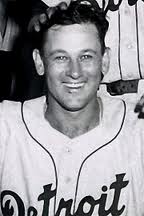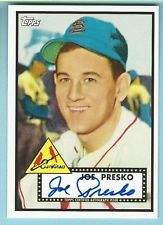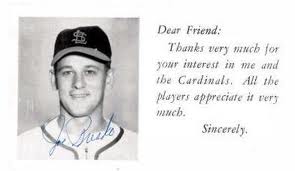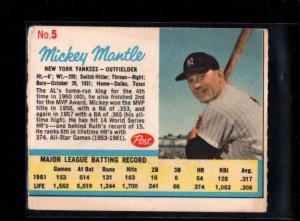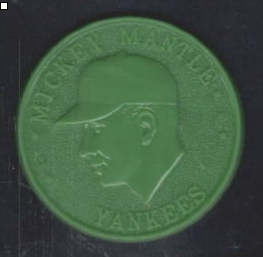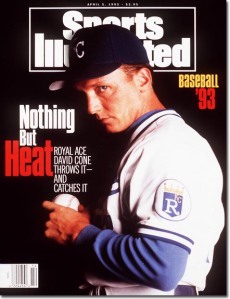Tagged: joe presko
Meet Uncle Joe
Recently I purchased the Topps baseball app, Pennant, for my iPhone. The app is $.99 and contains over 117,000 box scores dating back to 1952, the first year Topps printed baseball cards.
What interested me about the app is a story of family. My great-uncle, Joe Presko, was a pitcher on the 1951-54 Cardinals and split 22 innings between 57 and 58 with the Tigers. Joe is also featured in the first release of Topps baseball cards in 1952, card # 220.
I grew up always dreaming of playing baseball professionally one day. I always knew that great-uncle Joe played for the Cardinals and what I knew of Joe was told to me by grandmother who was Joe’s sister, and by my great-grandmother until her her death in the mid 1990’s. I still see Joe to this day at family gatherings but one thing that I never did was ask him about his time in baseball. I’m not sure he ever knew about my passion for the sport. Most of what I know about Joe’s today has to do with thumbing through old Cardinals yearbooks, perusing through sites like baseball almanac, fangraphs or baseball-reference.
When my great-grandmother died very few things were passed on to me. However, in my large Catholic family that I was surprised to receive even the things I did. My love of baseball was well known throughout my family and so I was given a copy of the 1951 Cardinals yearbook my great-grandmother had collected. A book that featured my uncle as well as several All Stars and Hall of Fame teammates such as; Stan Musial, Joe Garagiola, Red Scheondist, Peanuts Lowery, Enos Slaughter, Harvey Haddix, and Del Rice amoung others. It even included Harry Carey as the play by play man. Other items I received were a Mickey Mantle baseball card cut from the side of a post cereal box, a Mickey Mantle plastic coin and newspaper clippings and photos of Joe.
Growing up in the 80s and 90s only hard copies of baseball almanacs or encyclopedias were my only sources for stats. Having not yet been exposed to advanced metrics I found my great-uncles career numbers to be less than stellar. In 490 innings pitched Joe had amassed a 4.61 ERA with a record of 25-37 to go along with 202 strike outs and 5 saves. I was often looking for way to bring glamour to a career that was not mine but that I had found a connection to.
When I latched on to advanced metrics I was able to give my uncle career some meaning in my perspective. I am sure that Joe’s career always meant more to him and was not viewed as disappointing, save for the injuries that derailed it. But for myself I was looking to glorify it. As a youngster who dreamed of playing big league ball I had always dreamed of big league success. So having a very average career was not in my thoughts. How I would love to know have only a glint of underwhelming success in Independent baseball let along a day in the majors.
The advanced metric sites and the Pennant app helped me to find some of this glory. In his 6 year career Joe totaled a respectable 2.8 WAR. Had he not pitched through injury in 1954 that WAR would have surely surpassed 4.0. Looking through the Box scores I found that Joe had some very impressive single games that in themselves must have brought joy to many fans in attendance and excited the city of St. Louis at times.
Admittedly, without thumbing through most of the box scores in Joe’s career, I did stumble across what I feel is likely his best game ever pitched. Facing 4 future hall of famers and a roster littered with all star appearances, Joe took on the first place Brooklyn Dodgers on June 10th 1952. Joe got the 1-0 complete game win, pitching 10 innings, allowing 5 hits and 1 walk, while striking out 2. Both strikeouts recorded against Roy Campanella.
Other box score of note I found that impressed me are;
His first appearance came May 3, 1951 and he records 4 innings to get the win in relief also striking out 2 batters, Willie Jones and Del Ennis.
May 6, 1952 and Aug. 29, 1954 he strikesout Willie Mays.
Aug. 10, 1954 he strikeouts out Hank Aaron and Eddie Mathews. Two days later he would get Aaron again.
Multiple games recorded strikeouts against Roy Campanella.
After Joe’s playing career he went on to coach American Legion baseball back in Kansas City, mentoring David Cone along the way.
I personally have never spoken to Joe about his career and often wish I had, but ultimately I never really came to know him all that well that I felt comfortable starting the conversation. Once while a Royals game was on in the background and we had a brief and forgettable discussion on Gary Gaetti’s plate approach. I was about 10 years old and I don’t even recall my opinion at the time.
Maybe at the next family gathering I’ll ask Joe about what he remembers most and report back.
